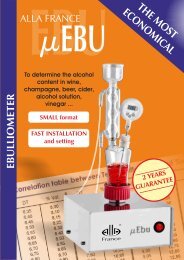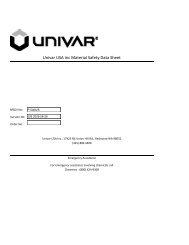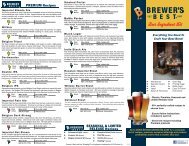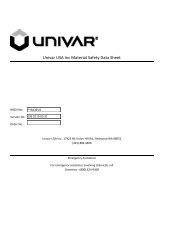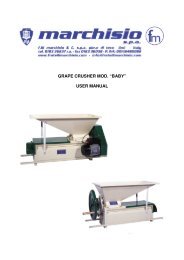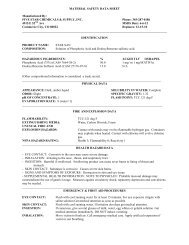Caustic Soda - Beads - LD Carlson Co.
Caustic Soda - Beads - LD Carlson Co.
Caustic Soda - Beads - LD Carlson Co.
Create successful ePaper yourself
Turn your PDF publications into a flip-book with our unique Google optimized e-Paper software.
Univar USA Inc Material Safety Data Sheet<br />
MSDS No:<br />
Version No:<br />
OZ32413<br />
007 2007-01-08<br />
Order No:<br />
Univar USA Inc., 17425 NE Union Hill Rd., Redmond WA 98052<br />
(425) 889 3400<br />
Emergency Assistance<br />
For emergency assistance involving chemicals call<br />
Chemtrec - (800) 424-9300
UNIVAR USA INC.<br />
MSDS NO:OZ32413<br />
ISSUE DATE:2004-04-07 VERSION:007 2007-01-08<br />
Annotation:<br />
The Version Date and Number for this MSDS is : 01/08/2007 - #007<br />
***************************************************************************<br />
PRODUCT IDENTIFICATION<br />
***************************************************************************<br />
PRODUCT NAME:<br />
CAUSTIC SODA ANHYDROUS (ALL GRADES)<br />
MSDS#:<br />
OZ32413<br />
DATE ISSUED: 04/07/2004<br />
SUPERSEDES: 05/06/2003<br />
ISSUED BY: 008730<br />
This MSDS was reviewed on 01/08/2007, and is<br />
current as of the DATE ISSUED above.<br />
MATERIAL SAFETY DATA SHEET<br />
1. CHEMICAL PRODUCT AND COMPANY IDENTIFICATION<br />
Distributed by:<br />
Univar USA Inc.<br />
17425 NE Union Hill Road<br />
Redmond, WA 98052<br />
425-889-3400<br />
SUBSTANCE: CAUSTIC SODA ANHYDROUS (ALL GRADES)<br />
TRADE NAMES:<br />
<strong>Caustic</strong> <strong>Soda</strong> - Solid; <strong>Caustic</strong> <strong>Soda</strong> - <strong>Beads</strong>; <strong>Caustic</strong> <strong>Soda</strong>- # 2 Flake;<br />
<strong>Caustic</strong> <strong>Soda</strong> - # 4 Flake; <strong>Caustic</strong> <strong>Soda</strong> - Rayon; <strong>Caustic</strong> <strong>Soda</strong> - Diaphragm;<br />
Diaphragm <strong>Co</strong>mpounder<br />
SYNONYMS:<br />
Sodium hydroxide - Dry<br />
PRODUCT USE: cleaner, process chemical, petroleum industry, food processing,<br />
metal finishing<br />
REVISION DATE: Apr 07 2004<br />
2. COMPOSITION, INFORMATION ON INGREDIENTS<br />
COMPONENT: SODIUM HYDROXIDE<br />
CAS NUMBER: 1310-73-2<br />
PERCENTAGE: 97-98.2
UNIVAR USA INC.<br />
MSDS NO:OZ32413<br />
ISSUE DATE:2004-04-07 VERSION:007 2007-01-08<br />
Annotation:<br />
COMPONENT:<br />
SODIUM CHLORIDE<br />
CAS NUMBER: 7647-14-5<br />
PERCENTAGE: 0-1.2<br />
COMPONENT: SODIUM CARBONATE<br />
CAS NUMBER: 497-19-8<br />
PERCENTAGE: 0.4-1.0<br />
3. HAZARDS IDENTIFICATION<br />
NFPA RATINGS (SCALE 0-4): HEALTH=3 FIRE=0 REACTIVITY=2<br />
HMIS RATINGS (SCALE 0-4): HEALTH=3 FLAMMABILITY=O REACTIVITY=2<br />
EMERGENCY OVERVIEW:<br />
COLOR:<br />
white<br />
PHYSICAL FORM: solid<br />
ODOR:<br />
odorless<br />
MAJOR HEALTH HAZARDS: MAY CAUSE BURNS TO THE RESPIRATORY TRACT, SKIN, EYES<br />
AND GASTROINTESTINAL TRACT. MAY CAUSE PERMANENT EYE DAMAGE.<br />
POTENTIAL HEALTH EFFECTS:<br />
INHALATION:<br />
SHORT TERM EXPOSURE: irritation (possibly severe), burns, pulmonary edema<br />
LONG TERM EXPOSURE: to our knowledge, no effects are known<br />
SKIN CONTACT:<br />
SHORT TERM EXPOSURE: irritation (possibly severe), burns<br />
LONG TERM EXPOSURE: dermatitis<br />
EYE CONTACT:<br />
SHORT TERM EXPOSURE: irritation (possibly severe), burns, eye damage,<br />
blindness<br />
LONG TERM EXPOSURE: visual disturbances<br />
INGESTION:<br />
SHORT TERM EXPOSURE: irritation (possibly severe), burns, nausea, vomiting<br />
LONG TERM EXPOSURE: to our knowledge, no effects are known<br />
CARCINOGEN STATUS:<br />
OSHA: No<br />
NTP: No<br />
IARC: No<br />
4. FIRST AID MEASURES<br />
INHALATION:<br />
If adverse effects occur, remove to uncontaminated area. Give artificial
UNIVAR USA INC.<br />
MSDS NO:OZ32413<br />
ISSUE DATE:2004-04-07 VERSION:007 2007-01-08<br />
Annotation:<br />
respiration if not breathing. If breathing is difficult, oxygen should be<br />
administered by qualified personnel. If respiration or pulse has stopped,<br />
have a trained person administer Basic Life Support (Cardio-Pulmonary<br />
Resuscitation/Automatic External Defibrillator) and CALL FOR EMERGENCY<br />
SERVICES IMMEDIATELY.<br />
SKIN CONTACT:<br />
Immediately flush contaminated areas with water. Remove contaminated<br />
clothing, jewelry, and shoes immediately. Wash contaminated areas with soap<br />
and water. Thoroughly clean and dry contaminated clothing and shoes before<br />
reuse. Discard footwear which cannot be decontaminated. GET MEDICAL<br />
ATTENTION IMMEDIATELY.<br />
EYE CONTACT:<br />
Immediately flush eyes with a directed stream of water for at least 15<br />
minutes, forcibly holding eyelids apart to ensure complete irrigation of all<br />
eye and lid tissues. Washing eyes within several seconds is essential to<br />
achieve maximum effectiveness. GET MEDICAL ATTENTION IMMEDIATELY.<br />
INGESTION:<br />
Never give anything by mouth to an unconscious or convulsive person. If<br />
swallowed, do not induce vomiting. Give large amounts of water. If vomiting<br />
occurs spontaneously, keep airway clear. Give more water when vomiting<br />
stops. GET MEDICAL ATTENTION IMMEDIATELY.<br />
NOTE TO PHYSICIAN: The absence of visible signs or symptoms of burns does<br />
NOT reliably exclude the presence of actual tissue damage.<br />
5. FIRE FIGHTING MEASURES<br />
FIRE AND EXPLOSION HAZARDS:<br />
Negligible fire hazard.<br />
EXTINGUISHING MEDIA:<br />
Do not use water. Use extinguishing agents appropriate for surrounding<br />
fire.<br />
FIRE FIGHTING:<br />
Move container from fire area if it can be done without risk.<br />
SENSITIVITY TO MECHANICAL IMPACT: Not sensitive<br />
SENSITIVITY TO STATIC DISCHARGE: Not sensitive<br />
FLASH POINT:<br />
not flammable<br />
6. ACCIDENTAL RELEASE MEASURES<br />
OCCUPATIONAL RELEASE:<br />
Shovel dry material into suitable container. Keep out of water supplies and<br />
sewers. This material is alkaline and may raise the pH of surface waters<br />
with low buffering capacity. Releases should be reported, if required, to<br />
appropriate agencies. Notify Local Emergency Planning <strong>Co</strong>mmittee and State
UNIVAR USA INC.<br />
MSDS NO:OZ32413<br />
ISSUE DATE:2004-04-07 VERSION:007 2007-01-08<br />
Annotation:<br />
Emergency Response <strong>Co</strong>mmission for release greater than or equal to RQ (U.S.<br />
SARA Section 304). If release occurs in the U.S. and is reportable under<br />
CERCLA Section 103, notify the National Response Center at (800)424-8802<br />
(USA) or (202)426-2675 (USA).<br />
STORAGE:<br />
Store and handle in accordance with all current regulations and standards.<br />
Keep container tightly closed and properly labeled. Do not store in aluminum<br />
container or use aluminum fittings or transfer lines, as flammable hydrogen<br />
gas may be generated. Keep separated from incompatible substances.<br />
HANDLING:<br />
Avoid breathing dust. Do not get in eyes, on skin, or on clothing. Wash<br />
thoroughly after handling. When mixing, slowly add to water to minimize heat<br />
generation and spattering.<br />
8. EXPOSURE CONTROLS, PERSONAL PROTECTION<br />
EXPOSURE LIMITS:<br />
SODIUM HYDROXIDE:<br />
2 mg/m3 OSHA TWA<br />
2 mg/m3 OSHA ceiling (vacated by 58 FR 35338, June 30, 1993)<br />
2 mg/m3 ACGIH ceiling<br />
2 mg/m3 MEXICO peak<br />
VENTILATION:<br />
Provide local exhaust ventilation where dust or mist may be generated.<br />
Ensure compliance with applicable exposure limits.<br />
EYE PROTECTION:<br />
Wear chemical resistant safety goggles if eye contact is likely. When wet<br />
mixing, wear splash resistant safety goggles with a faceshield. Provide an<br />
emergency eye wash fountain and quick drench shower in the immediate work<br />
area.<br />
CLOTHING:<br />
Wear protective clothing to minimize skin contact. When potential for contact<br />
with wet material exists, wear Tychem(R) SL or a similar chemical protective<br />
suit. When potential for contact with dry material exists, wear disposable<br />
coveralls such as Tyvek(R).<br />
GLOVES:<br />
Wear suitable gloves. Discard contaminated leather goods. When wet mixing,<br />
wear chemical resistant gloves such as butyl rubber, natural rubber,<br />
neoprene or nitrile.<br />
PROTECTIVE MATERIAL TYPES:<br />
butyl rubber, canvas, leather, natural rubber, neoprene, nitrile, Tychem<br />
(R), Tyvek(R)<br />
RESPIRATOR:
UNIVAR USA INC.<br />
MSDS NO:OZ32413<br />
ISSUE DATE:2004-04-07 VERSION:007 2007-01-08<br />
Annotation:<br />
A NIOSH approved respirator with N95 (dust, fume, mist) filters may be<br />
permissible under certain circumstances where airborne concentrations are<br />
expected to exceed exposure limits, or when symptoms have been observed<br />
that are indicative of overexposure.<br />
A half facepiece air-purifying respirator may be used in concentrations up<br />
to l OX the acceptable exposure level and a full facepiece air-purifying<br />
respirator may be used in concentrations up to 50X the acceptable exposure<br />
level.<br />
Supplied air should be used when the level is expected to be above 50X the<br />
acceptable level, or when there is a potential for uncontrolled release.<br />
A respiratory protection program that meets 29 CFR 1910.134 must be followed<br />
whenever workplace conditions warrant use of a respirator.<br />
9. PHYSICAL AND CHEMICAL PROPERTIES<br />
PHYSICAL STATE:<br />
solid<br />
COLOR:<br />
white<br />
ODOR:<br />
odorless<br />
MOLECULAR WEIGHT: 40.00<br />
MOLECULAR FORMULA:<br />
NaOH<br />
BOILING POINT:<br />
Not applicable<br />
MELTING POINT: 604 F (318 C)<br />
VAPOR PRESSURE:<br />
Not applicable<br />
VAPOR DENSITY:<br />
Not applicable<br />
SPECIFIC GRAVITY (water=1): 2.13 @ 20 C<br />
WATER SOLUBILITY: 100%<br />
PH:<br />
Not applicable<br />
VOLATILITY: 0%<br />
ODOR THRESHO<strong>LD</strong>:<br />
Not available<br />
EVAPORATION RATE:<br />
Not applicable<br />
COEFFICIENT OF WATER/OIL DISTRIBUTION: Not available<br />
10. STABILITY AND REACTIVITY<br />
REACTIVITY:<br />
Stable at normal temperatures and pressure.<br />
CONDITIONS TO AVOID:<br />
Avoid contact with water. Direct contact with water may cause an exothermic<br />
reaction. Carbon monoxide gas may form upon contact with reducing sugars,<br />
food and beverage products in enclosed spaces.<br />
INCOMPATIBILITIES:<br />
acids, halogenated compounds, prolonged contact with aluminum, brass, bronze,<br />
copper, lead, tin, zinc or other alkali sensitive metals or alloys<br />
HAZARDOUS DECOMPOSITION:<br />
Thermal decomposition products: None known.<br />
POLYMERIZATION: Will not polymerize.<br />
11. TOXICOLOGICAL INFORMATION
UNIVAR USA INC.<br />
MSDS NO:OZ32413<br />
ISSUE DATE:2004-04-07 VERSION:007 2007-01-08<br />
Annotation:<br />
CAUSTIC SODA ANHYDROUS (ALL GRADES):<br />
TOXICITY DATA: Sodium Hydroxide: 1350 mg/kg Dermal-Rabbit <strong>LD</strong>50.220 mg/kg<br />
(50% solution) Oral-Rat <strong>LD</strong>50. As a solid, this material interacts with moist<br />
tissue to cause damage. When in solution, this material will affect all<br />
tissues with which it comes in contact. The severity of the tissue damage is<br />
a function of its concentration, the length of tissue contact time, and local<br />
tissue conditions. After exposure there may be a time delay before irritation<br />
and other effects occur. This material is a strong irritant and is corrosive<br />
to the skin, eyes, and mucous membranes. This material may cause severe burns<br />
and permanent damage to any tissue with which it comes into contact.<br />
Inhalation will cause severe irritation, possible burns with pulmonary edema,<br />
which may lead to pneumonitis. Skin contact with this material may cause<br />
severe irritation and corrosion of tissue. Eye contact can cause severe<br />
irritation, corrosion with possible corneal damage and blindness. In general,<br />
chronic effects are due to long-term irritation. This material may cause<br />
dermatitis on the skin, or recurrent corneal ulceration and visual<br />
disturbances. In rare cases reports have noted long-term inhalation causes<br />
bronchial inflammatory reaction or obstructive airway dysfunction.<br />
12. ECOLOGICAL INFORMATION<br />
ECOTOXICITY DATA:<br />
FISH TOXICITY: This material has exhibited moderate toxicity to aquatic<br />
organisms.<br />
FATE AND TRANSPORT:<br />
BIODEGRADATION: This material is inorganic and not subject to<br />
biodegradation.<br />
PERSISTENCE: This material will exist in the disassociated state.<br />
BIOCONCENTRATION: This material is believed not to bioaccumulate.<br />
OTHER ECOLOGICAL INFORMATION: This material has exhibited slight toxicity<br />
to terrestrial organisms.<br />
13. DISPOSAL CONSIDERATIONS<br />
Reuse or reprocess if possible. Dispose in accordance with all applicable<br />
regulations.<br />
14. TRANSPORT INFORMATION<br />
U.S. DOT 49 CFR 172.101:<br />
PROPER SHIPPING NAME: Sodium hydroxide, solid<br />
ID NUMBER:<br />
UN1823<br />
HAZARD CLASS OR DIVISION: 8<br />
PACKING GROUP:<br />
II<br />
LABELING REQUIREMENTS: 8<br />
DOT HAZARDOUS SUBSTANCE(S):
UNIVAR USA INC.<br />
MSDS NO:OZ32413<br />
ISSUE DATE:2004-04-07 VERSION:007 2007-01-08<br />
Annotation:<br />
Sodium hydroxide 1000 lb(s) (454 kg(s))<br />
CANADIAN TRANSPORTATION OF DANGEROUS GOODS:<br />
SHIPPING NAME:<br />
Sodium hydroxide, solid<br />
UN NUMBER: UN 1823<br />
CLASS: 8<br />
PACKING GROUP/RISK GROUP: II<br />
15. REGULATORY INFORMATION<br />
U.S. REGULATIONS:<br />
CERCLA SECTIONS 102a/103 HAZARDOUS SUBSTANCES (40 CFR 302.4):<br />
SODIUM HYDROXIDE: 1000 LBS RQ<br />
SARA TITLE III SECTION 302 EXTREMELY HAZARDOUS SUBSTANCES (40 CFR 355.30):<br />
Not regulated.<br />
SARA TITLE III SARA SECTIONS 311/312 HAZARDOUS CATEGORIES (40 CFR 370.21):<br />
ACUTE:<br />
CHRONIC:<br />
FIRE:<br />
REACTIVE:<br />
SUDDEN RELEASE:<br />
Yes<br />
No<br />
No<br />
Yes<br />
No<br />
SARA TITLE III SECTION 313 (40 CFR 372.65): Not regulated.<br />
OSHA PROCESS SAFETY (29CFR1910.119): Not regulated.<br />
STATE REGULATIONS:<br />
California Proposition 65: This product may contain contaminants known to<br />
the State of California to cause cancer or reproductive toxicity as listed<br />
under Proposition 65 State Drinking Water and Toxic Enforcement Act.<br />
For additional information, contact Customer Service.<br />
NEW JERSEY WORKER AND COMMUNITY RIGHT TO KNOW:<br />
REPORTING REQUIREMENT:<br />
SODIUM HYDROXIDE 1310-73-2 97-98.2%<br />
SODIUM CHLORIDE 7647-14-5 0-1.2%<br />
SODIUM CARBONATE 497-19-8 0.4-1.0%<br />
RIGHT TO KNOW HAZARDOUS SUBSTANCE LIST:<br />
SODIUM HYDROXIDE 1310-73-2 97-98.2%<br />
SPECIAL HEALTH HAZARD SUBSTANCE LIST:<br />
SODIUM HYDROXIDE 1310-73-2 97-98.2%<br />
PENNSYLVANIA RIGHT TO KNOW:<br />
REPORTING REQUIREMENT:<br />
SODIUM HYDROXIDE 1310-73-2 97-98.2%<br />
HAZARDOUS SUBSTANCE LIST:<br />
SODIUM HYDROXIDE 1310-73-2 97-98.2%<br />
ENVIRONMENTAL HAZARDOUS SUBSTANCE LIST:
UNIVAR USA INC.<br />
MSDS NO:OZ32413<br />
ISSUE DATE:2004-04-07 VERSION:007 2007-01-08<br />
Annotation:<br />
SODIUM HYDROXIDE 1310-73-2 97-98.2%<br />
SPECIAL HAZARDOUS SUBSTANCE LIST:<br />
Not regulated.<br />
CANADIAN REGULATIONS:<br />
CONTROLLED PRODUCTS REGULATIONS (CPR): This product has been classified in<br />
accordance with the criteria of the <strong>Co</strong>ntrolled Products Regulations (CPR)<br />
and the MSDS contains all of the information required by the CPR.<br />
WHMIS CLASSIFICATION: D 1 B, E.<br />
NATIONAL INVENTORY STATUS:<br />
U.S. INVENTORY (TSCA): All the components of this substance are listed on<br />
or are exempt from the inventory.<br />
TSCA 12(b) EXPORT NOTIFICATION: Not listed.<br />
CANADA INVENTORY (DSL/NDSL): All components of this product are listed on<br />
the DSL.<br />
MSDS SUMMARY OF CHANGES
Univar USA Inc Material Safety Data Sheet<br />
For Additional Information contact MSDS <strong>Co</strong>ordinator during business hours, Pacific time: (425) 889-3400<br />
Notice<br />
Univar USA Inc. (”Univar”) expressly disclaims all express or implied warranties of merchantability and fitness for<br />
a particular purpose, with respect to the product or information provided herein, and shall under no<br />
circumstances be liable for incidental or consequential damages.<br />
Do not use ingredient information and/or ingredient percentages in this MSDS as a product specification. For<br />
product specification information refer to a product specification sheet and/or a certificate of analysis. These<br />
can be obtained from your local Univar sales office.<br />
All information appearing herein is based upon data obtained from the manufacturer and/or recognized<br />
technical sources. While the information is believed to be accurate, Univar makes no representations as to its<br />
accuracy or sufficiency. <strong>Co</strong>nditions of use are beyond Univar's control and therefore users are responsible to<br />
verify this data under their own operating conditions to determine whether the product is suitable for their<br />
particular purposes and they assume all risks of their use, handling, and disposal of the product, or from the<br />
publication or use of, or reliance upon, information contained herein.<br />
This information relates only to the product designated herein, and does not relate to its use in combination<br />
with any other material or in any other process



